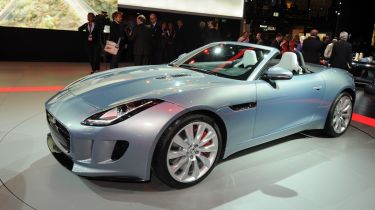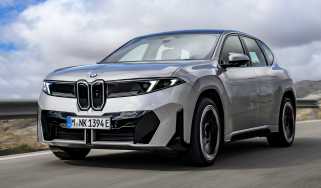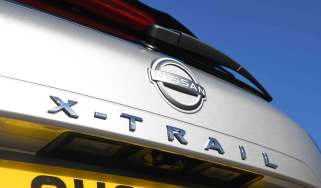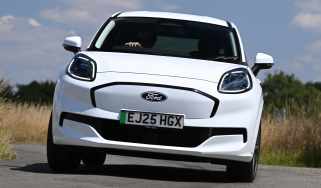Jaguar F-Type on the road
We get an exclusive ride in the stunning new Jaguar F-Type, ahead of its arrival in showrooms in April
The F-Type has been designed to form a bond with the driver, so we can’t deliver a verdict from the passenger seat. But if the point of a sports car is to deliver excitement at every opportunity, it’s on the right track. From the rabid acceleration to the tight body control, it’s every bit as thrilling as we were hoping for. From where we were sitting, the F-Type combines elegance and agility like nothing else on the road.
“Roof up or roof down?” asks Mike Cross, Jaguar’s chief test engineer, as we peer out at the icy-cold January weather. “Down. Definitely down,” we reply, and prepare our ears for the onslaught.
Twelve seconds later, roof stowed, we pull out of the lay-by and Cross wastes no time in showing us what he’s been working on. Throttle pinned, the F-Type explodes up the road, leaving a crisp metallic bark behind us punctuated with pops on every upshift and blips on every downshift. Arriving at the first corner, he tucks the nose in neatly and drifts the car at a perfect 45 degree angle to our direction of travel. Suddenly we understand why there’s a grab handle sticking out from the centre console.
We’re not here to get behind the wheel of the F-Type – that comes in April – but to be driven by the test team responsible for its development. And we’re on the exact Welsh B-roads where its handling and performance have been fine-tuned. Passenger rides can often be a frustrating, but when the car is the most important new Jaguar since the 1961 E-Type, it’s an opportunity not to be missed.
Used - available now

2023 Ford
Puma
34,782 milesManualPetrol1.0L
Cash £13,697
2016 Vauxhall
Mokka
40,078 milesAutomaticPetrol1.4L
Cash £7,980
2024 Fiat
500
32,985 milesManualPetrol1.0L
Cash £10,795“We’ve done more work on-track developing the F-Type, at places such as Rockingham and the Nurburgring, than any other model,” Cross reveals. “But these roads are its home. If it works here, it will work anywhere.”
We can see what he means. Inconsistent surfaces, narrow sections, blind crests and high hedges are only some of the obstacles the F-Type has to tackle, but not once does it feel out of place. It’s a mere 1.1cm broader than the Porsche 911 Cabriolet (a car Jaguar used as a benchmark despite the F-Type costing £21,447 less) but it never feels unnecessarily wide – even with lorries steaming past in the other direction.
We’re sitting 20mm lower than in the XKR-S, so the sensation is more like skimming the surface than riding above it. More obvious is how much tighter the body control is than with the bigger XK. The F-Type uses a development of that car’s aluminium chassis – stiffened, 130mm removed from the wheelbase, plus shorter overhangs help to concentrate the mass between the wheels. Front-to-back weight distribution is a near-perfect 50:50 in the V6.
Over crests and dips we can feel the car moving vertically on its suspension (both the V6 S and V8 S get adaptive dampers, while the base V6 has fixed-rate springs). However, it refuses to nose-dive, even when hard on the brakes, while body roll is not an issue. The price to pay is a bumpy ride as we cruise through villages, but the harder the car is driven, the more fluid it feels.
The test team’s consensus is that the V6, offered with 335bhp, or 375bhp in the S, is for the more accomplished driver, while the 488bhp V8 S is for those who prefer their fun in straight lines. “We tried to set up both to feel as similar as possible, but personally I prefer the V6 – it just feels nicely balanced,” Cross reveals. After riding in both, we’d have to agree.
The main differences are clear within the first few miles. The way the V8 punches out of corners, or in any gear at any time, squeezes the air from our lungs. Meanwhile, the V6 S builds speed less immediately, with a crescendo as you reach high revs. But with less weight in the nose (the V8 weighs 54kg more), the V6 tucks into corners a little quicker.
You can tell the models apart from their exhaust notes, too: the V8 emits a deep rumble overlaid with fluttering valves, while the V6 makes a metallic blare with crackles on the overrun. An active exhaust, which opens a set of valves above 3,000rpm (or permanently if you push a button), is standard on both S versions.
A Dynamic mode sharpens throttle response, adds steering weight, firms up the suspension and speeds up shifts on the remarkable new eight-speed box. Prefer a sharper throttle response but not added steering weight or harder dampers? Each parameter is individually configurable, too.
Some may argue that Jaguar should have used a twin-clutch gearbox, but we’d disagree. This ZF-developed transmission offers the best of both worlds, with seamless low-speed changes and barely any interruption in the torque on upshifts. Jaguar has even engineered in a little kick from the transmission on full-throttle upshifts in Dynamic mode, to make it feel more alive.
Frustratingly, Cross’s favourite part of the car is something we can’t try at this stage. “I’m most proud of the steering,” he tells us. “With a sports car it’s the most important element, and I’m confident we’ve got it just right.”
Unlike the new 911, which uses an electric system, the F-Type sticks with a proven hydraulic set-up. It has the quickest ratio of any Jaguar road car to date. “As you turn the wheel the ratio gets even quicker,” Cross explains. “My job is to make you are unaware of that change, so it feels entirely linear and natural.”
While our evaluation of the steering will have to wait a few months, there’s plenty to admire from the passenger seat. You often hear makers describe cabins as “driver focused” or “cockpit-like”, but the F-Type bring new meaning to both phrases. While the passenger is presented with a bare dashboard, glovebox and two grab handles, the driver has an array of buttons and switches at their disposal.
The joystick-like gear selector and rocker switch to select Dynamic are based on a fighter-jet theme, while all the knobs and dials work with a satisfying mechanical click and feel high-quality to the touch. And this is a pre-production prototype, don’t forget, so things are likely to further improve. Those who like the drama of the XF, XJ and XK’s rising dial won’t be disappointed, either – when the car senses it’s too cold or too warm, two vents appear almost magically from the top of the dash.
As for the styling, you’ve probably already formed your own opinions – but just wait until you watch an F-Type drive past. It’s not an especially radical design, but it’s one that’s impossibly elegant from just about all angles.
Key specs
| 3.0 V6 | 3.0 V6 S | 5.0 V8 S | |
| Price | £58,500 | £67,500 | £79,950 |
| Engine | 3.0-litre V6 s/c | 3.0-litre V6 s/c | 5.0-litre V8 s/c |
| Power | 335bhp | 375bhp | 488bhp |
| 0-62mph | 5.3 seconds | 4.9 seconds | 4.3 seconds |
| CO2 | 209g/km | 213g/km | 259g/km |
| On sale | 19-Apr | 19-Apr | 19-Apr |



